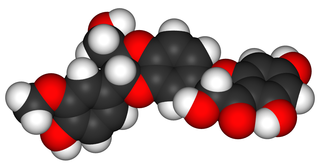Silibinin: Difference between revisions
m (Protected "Silibinin": Protecting pages from unwanted edits ([edit=sysop] (indefinite) [move=sysop] (indefinite))) |
No edit summary |
||
| (3 intermediate revisions by the same user not shown) | |||
| Line 1: | Line 1: | ||
{{Drugbox| | {{Drugbox | ||
|IUPAC_name = | | Verifiedfields = changed | ||
| image = Silibinin | | verifiedrevid = 464390273 | ||
| image2 = | | IUPAC_name = (2''R'',3''R'')-3,5,7-trihydroxy-<br />2-[(2''R'',3''R'')-3-(4-hydroxy-3-methoxyphenyl)-2-(hydroxymethyl)<br />-2,3-dihydrobenzo[''b''][1,4]dioxin-6-yl]chroman-4-one | ||
| CAS_number= 22888-70-6 | | image = Silibinin.png | ||
| ATC_prefix= | | image2 = Silibinin0.png | ||
| ATC_suffix= | |||
| PubChem= 31553 | <!--Clinical data--> | ||
| | | tradename = | ||
| C = 25 |H = 22 |O = 10 | | Drugs.com = {{drugs.com|international|silibinin}} | ||
| routes_of_administration = [[Oral administration|Oral]] [[Intravenous therapy|Intravenous]] | |||
<!--Identifiers--> | |||
| CAS_number_Ref = {{cascite|changed|??}} | |||
| CAS_number = 22888-70-6 | |||
| ATC_prefix = A05 | |||
| ATC_suffix = BA03 | |||
| PubChem = 31553 | |||
| DrugBank_Ref = {{drugbankcite|correct|drugbank}} | |||
| ChemSpiderID_Ref = {{chemspidercite|correct|chemspider}} | |||
| ChemSpiderID = 29263 | |||
| ChEBI_Ref = {{ebicite|changed|EBI}} | |||
| ChEBI = 9144 | |||
| UNII_Ref = {{fdacite|correct|FDA}} | |||
| UNII = 4RKY41TBTF | |||
| KEGG_Ref = {{keggcite|correct|kegg}} | |||
| KEGG = D08515 | |||
| ChEMBL_Ref = {{ebicite|changed|EBI}} | |||
| ChEMBL = 9509 | |||
<!--Chemical data--> | |||
| C=25 | H=22 | O=10 | |||
| molecular_weight = 482.44 g/mol | | molecular_weight = 482.44 g/mol | ||
| | | smiles = O=C4c5c(O)cc(O)cc5O[C@H](c2ccc1O[C@@H]([C@H](Oc1c2)c3ccc(O)c(OC)c3)CO)[C@H]4O | ||
| | | InChI = 1/C25H22O10/c1-32-17-6-11(2-4-14(17)28)24-20(10-26)33-16-5-3-12(7-18(16)34-24)25-23(31)22(30)21-15(29)8-13(27)9-19(21)35-25/h2-9,20,23-29,31H,10H2,1H3/t20-,23+,24-,25-/m1/s1 | ||
| | | InChIKey = SEBFKMXJBCUCAI-HKTJVKLFBV | ||
| | | StdInChI_Ref = {{stdinchicite|correct|chemspider}} | ||
| | | StdInChI = 1S/C25H22O10/c1-32-17-6-11(2-4-14(17)28)24-20(10-26)33-16-5-3-12(7-18(16)34-24)25-23(31)22(30)21-15(29)8-13(27)9-19(21)35-25/h2-9,20,23-29,31H,10H2,1H3/t20-,23+,24-,25-/m1/s1 | ||
| | | StdInChIKey_Ref = {{stdinchicite|correct|chemspider}} | ||
| | | StdInChIKey = SEBFKMXJBCUCAI-HKTJVKLFSA-N | ||
}} | }} | ||
'''Silibinin''' ([[International Nonproprietary Name|INN]], also known as '''silybin''' | __NOTOC__ | ||
{{SI}} | |||
{{CMG}} | |||
==Overview== | |||
'''Silibinin''' ([[International Nonproprietary Name|INN]]), also known as '''silybin '''(both from ''[[Silybum]]'', the [[Genus–differentia definition|generic]] name of the [[plant]] from which it is extracted), is the major active constituent of '''silymarin''', a standardized extract of the [[Silybum marianum|milk thistle]] seeds, containing a mixture of [[flavonolignan]]s consisting of silibinin, [[isosilibinin]], [[silicristin]], [[silidianin]] and others. Silibinin itself is mixture of two [[diastereomer]]s, silybin A and silybin B, in approximately equimolar ratio.Both ''in vitro'' and animal research suggest that silibinin has [[hepatoprotective]] (antihepatotoxic) properties that protect liver cells against toxins. Silibinin has also demonstrated ''in vitro'' anti-cancer effects against human prostate adenocarcinoma cells, estrogen-dependent and -independent human breast carcinoma cells, human ectocervical carcinoma cells, human colon cancer cells, and both small and nonsmall human lung carcinoma cells. | |||
Chemically modified silibinin, silibinin dihydrogen disuccinate disodium (trade name '''Legalon SIL''') a solution for [[injection (medicine)|injection]], is | Chemically modified silibinin, silibinin dihydrogen disuccinate disodium (trade name '''Legalon SIL'''), a solution for [[injection (medicine)|injection]], is currently being tested as a treatment of severe intoxications with hepatotoxic substances, such as [[Amanita phalloides|death cap]] (''Amanita phalloides'') poisoning.There is also clinical evidence for the use of silibinin as a supportive element in alcoholic and child grade 'A' [[liver cirrhosis]]. | ||
==Pharmacology== | ==Pharmacology== | ||
Poor water solubility and [[bioavailability]] of silymarin led to the development of enhanced formulations. '''Silipide''' (trade name '''Siliphos'''), a complex of silymarin and [[phosphatidylcholine]] (lecithin), is about | Poor water solubility and [[bioavailability]] of silymarin led to the development of enhanced formulations. '''Silipide''' (trade name '''Siliphos'''), a complex of silymarin and [[phosphatidylcholine]] (lecithin), is about 10 times more bioavailable than silymarin. It has been also reported that silymarin inclusion complex with β-[[cyclodextrin]] is much more soluble than silymarin itself.There have also been prepared [[glycoside]]s of silybin, which show better water solubility and even stronger hepatoprotective effect. | ||
Silymarin, as other [[flavonoid]]s, has been shown to inhibit P- | Silymarin is the first ingredient in several products sold as herbal telomerase activators, though the research demonstrating silymarin's effectiveness in this regard is proprietary and unpublished. | ||
Silymarin, as other [[flavonoid]]s, has been shown to inhibit [[P-glycoprotein]]-mediated cellular efflux. The modulation of P-glycoprotein activity may result in altered absorption and bioavailability of drugs that are P-glycoprotein substrates. It has been reported that silymarin inhibits [[cytochrome P450]] enzymes and an interaction with drugs primarily cleared by P450s cannot be excluded. | |||
==Toxicity== | ==Toxicity== | ||
A [[phase I clinical trial]] in humans with prostate cancer designed to study the effects of high dose silibinin found 13 grams daily to be well tolerated in patients with advanced prostate cancer with asymptomatic liver toxicity ([[hyperbilirubinemia]] and elevation of [[alanine aminotransferase]]) being the most commonly seen adverse event. | |||
== | The compound is also devoid of embryotoxic potential in animal models. | ||
== Potential medical uses == | |||
A recent study suggested that silymarin may help patients with [[type II diabetes]] by assisting in blood sugar control. | |||
Lab experiments on mice showed that silibinin protects the hepatic cells against the toxin [[alpha-amanitin]] which causes ''[[Amanita phalloides]]'' mushroom poisoning. | |||
== Biotechnology == | |||
Silymarin can be produced in [[callus (cell biology)|callus]] and cells suspensions of ''[[Silybum marianum]]'' and substituted [[pyrazinecarboxamide]]s can be used as abiotic [[elicitor]]s of flavolignan production. | |||
==References== | ==References== | ||
{{Reflist|2}} | |||
[[Category:Antidotes]] | [[Category:Antidotes]] | ||
[[Category: | [[Category:Phenols]] | ||
[[Category: | [[Category:Drug]] | ||
Latest revision as of 16:59, 9 April 2015
 | |
 | |
| Clinical data | |
|---|---|
| AHFS/Drugs.com | International Drug Names |
| Routes of administration | Oral Intravenous |
| ATC code | |
| Identifiers | |
| |
| CAS Number | |
| PubChem CID | |
| ChemSpider | |
| UNII | |
| KEGG | |
| ChEBI | |
| ChEMBL | |
| E number | {{#property:P628}} |
| ECHA InfoCard | {{#property:P2566}}Lua error in Module:EditAtWikidata at line 36: attempt to index field 'wikibase' (a nil value). |
| Chemical and physical data | |
| Formula | C25H22O10 |
| Molar mass | 482.44 g/mol |
| 3D model (JSmol) | |
| |
| |
| | |
|
WikiDoc Resources for Silibinin |
|
Articles |
|---|
|
Most recent articles on Silibinin |
|
Media |
|
Evidence Based Medicine |
|
Clinical Trials |
|
Ongoing Trials on Silibinin at Clinical Trials.gov Clinical Trials on Silibinin at Google
|
|
Guidelines / Policies / Govt |
|
US National Guidelines Clearinghouse on Silibinin
|
|
Books |
|
News |
|
Commentary |
|
Definitions |
|
Patient Resources / Community |
|
Patient resources on Silibinin Discussion groups on Silibinin Directions to Hospitals Treating Silibinin Risk calculators and risk factors for Silibinin
|
|
Healthcare Provider Resources |
|
Causes & Risk Factors for Silibinin |
|
Continuing Medical Education (CME) |
|
International |
|
|
|
Business |
|
Experimental / Informatics |
Editor-In-Chief: C. Michael Gibson, M.S., M.D. [1]
Overview
Silibinin (INN), also known as silybin (both from Silybum, the generic name of the plant from which it is extracted), is the major active constituent of silymarin, a standardized extract of the milk thistle seeds, containing a mixture of flavonolignans consisting of silibinin, isosilibinin, silicristin, silidianin and others. Silibinin itself is mixture of two diastereomers, silybin A and silybin B, in approximately equimolar ratio.Both in vitro and animal research suggest that silibinin has hepatoprotective (antihepatotoxic) properties that protect liver cells against toxins. Silibinin has also demonstrated in vitro anti-cancer effects against human prostate adenocarcinoma cells, estrogen-dependent and -independent human breast carcinoma cells, human ectocervical carcinoma cells, human colon cancer cells, and both small and nonsmall human lung carcinoma cells.
Chemically modified silibinin, silibinin dihydrogen disuccinate disodium (trade name Legalon SIL), a solution for injection, is currently being tested as a treatment of severe intoxications with hepatotoxic substances, such as death cap (Amanita phalloides) poisoning.There is also clinical evidence for the use of silibinin as a supportive element in alcoholic and child grade 'A' liver cirrhosis.
Pharmacology
Poor water solubility and bioavailability of silymarin led to the development of enhanced formulations. Silipide (trade name Siliphos), a complex of silymarin and phosphatidylcholine (lecithin), is about 10 times more bioavailable than silymarin. It has been also reported that silymarin inclusion complex with β-cyclodextrin is much more soluble than silymarin itself.There have also been prepared glycosides of silybin, which show better water solubility and even stronger hepatoprotective effect.
Silymarin is the first ingredient in several products sold as herbal telomerase activators, though the research demonstrating silymarin's effectiveness in this regard is proprietary and unpublished.
Silymarin, as other flavonoids, has been shown to inhibit P-glycoprotein-mediated cellular efflux. The modulation of P-glycoprotein activity may result in altered absorption and bioavailability of drugs that are P-glycoprotein substrates. It has been reported that silymarin inhibits cytochrome P450 enzymes and an interaction with drugs primarily cleared by P450s cannot be excluded.
Toxicity
A phase I clinical trial in humans with prostate cancer designed to study the effects of high dose silibinin found 13 grams daily to be well tolerated in patients with advanced prostate cancer with asymptomatic liver toxicity (hyperbilirubinemia and elevation of alanine aminotransferase) being the most commonly seen adverse event.
The compound is also devoid of embryotoxic potential in animal models.
Potential medical uses
A recent study suggested that silymarin may help patients with type II diabetes by assisting in blood sugar control.
Lab experiments on mice showed that silibinin protects the hepatic cells against the toxin alpha-amanitin which causes Amanita phalloides mushroom poisoning.
Biotechnology
Silymarin can be produced in callus and cells suspensions of Silybum marianum and substituted pyrazinecarboxamides can be used as abiotic elicitors of flavolignan production.
References
- Pages with script errors
- Template:drugs.com link with non-standard subpage
- Articles with changed CASNo identifier
- Articles with changed EBI identifier
- E number from Wikidata
- ECHA InfoCard ID from Wikidata
- Chemical articles with unknown parameter in Infobox drug
- Chemical pages without DrugBank identifier
- Drugs with no legal status
- Drugboxes which contain changes to verified fields
- Antidotes
- Phenols
- Drug